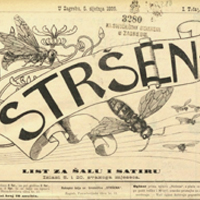
Podravski jež de Dragutin Antolek fue la primera revista humorística en idioma croata. Su editor fue un defensor de Varaždin contra la influencia alemana y húngara, ilírico, jurista y político. El primer número se publicó el 17 de marzo de 1862 con una tirada de 2.000 ejemplares. El humorismo es la forma periodística más difícil, y cuando se le añade la censura y la estricta vigilancia de los gobernantes, era difícil sobrevivir para la revista y sus editores en esas condiciones. La caída del absolutismo de Bach junto con la disminución de la influencia germánica ayudó a la popularidad de la revista. Los habitantes de estas regiones siempre han tenido una inclinación al chiste, las bromas y los juegos de palabras, en lo que Antolek destacaba. La revista salía cada día 10, 20 y 30 del mes. La primera convocatoria pública para suscribirse tras la impresión de 1.100 ejemplares fue enviada por el editor a los ciudadanos ya el 12 de octubre de 1861, pero la respuesta fue poca.
Como indica la fuente (Anuario del Museo Municipal, nº 6, Varaždin 1981, artículo de Antun Golob): "Era una publicación cuadrada de 60x50 cm, en cuatro páginas, ilustrada con grabados. Predominaban textos muy mordaces dirigidos contra los alemanes y la germanización. Bajo el título 'Podravski jež' aparecía la imagen de un erizo sentado sobre sus patas traseras comiendo de la chistera de un 'schwabe' (término despectivo para los alemanes) y, bajo la imagen, el lema: 'Compadre, confía en ti mismo y en tu propio caballo'. El resto de las páginas, junto con canciones de despertar y dibujos provocativos, estaban llenas de bromas y dibujos. En la última página había un dibujo de un alemán con frac y chistera, de pie ante una olla grande (sobre el fuego del campamento), cocinando salchichas 'frankfurter', ofreciéndolas a dos croatas vestidos con surcos (abrigo corto de paño)." El periódico oportunista contrario a Jež era el orientado a los húngaros, Agramer Zeitung de Zagreb.
El difícil periodo que fue decayendo lentamente fortaleció en la gente el optimismo, el buen ánimo y una inclinación cada vez mayor a la risa y la buena disposición, como estímulo para tiempos mejores. La sátira mordaz de Antolek se dirigía principalmente contra sus enemigos nacionales y políticos. Varaždin era conocido como la ciudad de los príncipes legendarios del humor y la sátira. Eran populares en aquel tiempo las llamadas huncutarije –pequeñas bromas características de la región de Varaždin. Sobre sus bases surgieron las primeras obras literarias satíricas conocidas: “Matijaš Grabancijaš Dijak” de Tituš Brezovački y “Petrica Kerempuh” de Jakob Lovrenčić. Antes de eso, en 1848, en Varaždin se publicó solo un número de Lucifer, pero en idioma alemán.
Por poco tiempo (del 1 de julio de 1877 al 31 de marzo de 1878) se publicó en Zagreb la revista humorística Humoristički list, bajo la dirección de Vjekoslav Raić. La revista era semimensual y de formato de 32 cm de alto.
Unos años más tarde en Croacia se publicaron varias revistas humorísticas más, con fuerte acento político. La primera y quizás la más famosa de todas fue Vragoljan de Bakra. Se trataba de un quincenal dirigido por Josip Horvat, donde se exaltaba marcadamente el derecho y Ante Starčević –‘padre de la patria’. La revista se publicó entre 1881 y 1886 y fue confiscada 32 veces, entre otras cosas por propagar el culto de los Zrinski y Frankopan, con claras posturas anti-Viena. El humor de la revista era forzado, el espíritu crítico, con ilustraciones pobres y personajes deformes. La revista satírica de tendencia prava Bič se publicó en Zagreb entre 1883 y 1885. Los textos y dibujos iban principalmente dirigidos contra el ban Karoly Khuen-Hedervary. La editaba Gavro Grünhut y nada menos que 27 de los 39 números fueron censurados.
En Zagreb, entre 1891 y 1899, se publicó la más longeva de las mencionadas, la revista Trn. Su editor principal fue Josip Zvečeka (copublicada junto al político Ante Starčević, destacado pravaš). Se sabe que salía dos veces al mes y, del total de números, 28 llegaron a ser confiscados. Su longevidad se debió a que el humor era más suave y casi inofensivo para el régimen entonces vigente. Le siguió la revista de humor y sátira Stršen, que apareció a fines del siglo XIX (1899-1900), editada por Ivan Lončarić y publicada por Mirko Supek. Un tercio de sus números (16 de 46) fueron confiscados, y se imprimía los días 5 y 20 de cada mes en papel de 42 cm de alto, también en Zagreb. Debido a frecuentes prohibiciones, algunos números censurados salían como segunda edición. El Zagrebački Tries, desde noviembre de 1885 hasta mayo de 1886, lo editó Stjepan Zavrlić. Esta revista fue la verdadera sucesora de Bič, con el apoyo editorial de Iván Krajač como editor. Fueron confiscados 4 de sus 14 números.
El primer periódico humorístico en Eslavonia fue Novogradiško blebetalo, aparecido en 1895 en Nova Gradiška gracias a HPD Graničar y la imprenta de Mavro Bauer. El primer número salió el 9 de junio de 1895 en el jardín de la vieja cervecería de Nova Gradiška con motivo de un concierto benéfico para los afectados por el terremoto en Liubliana (Eslovenia). De este periódico humorístico editado por Iván Zatluke y amigos sólo se publicó un número. En él se ridiculizaban de manera divertida los defectos locales y las carencias sociales. Como señala una fuente de Internet (https://novagra.hr): “una multitud de textos en prosa y verso en los que predominan los problemas políticos y comunales, concursos cómicos, agradecimientos, anuncios matrimoniales y otros adornos urbanos.” Los sucesores de la revista fueron: Blebetalo, Veseli brat, Komarac y Aprilska trava, sobre los que hablaremos más en la siguiente entrega.
(This text has been translated into Spanish by Chat GPT)
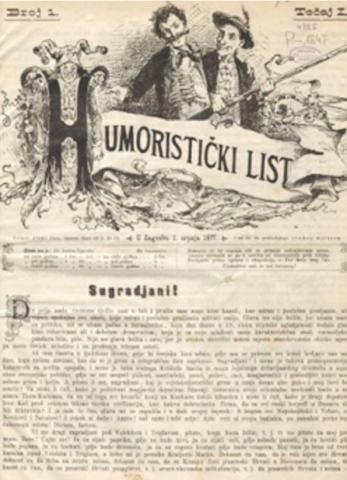
Humoristički list
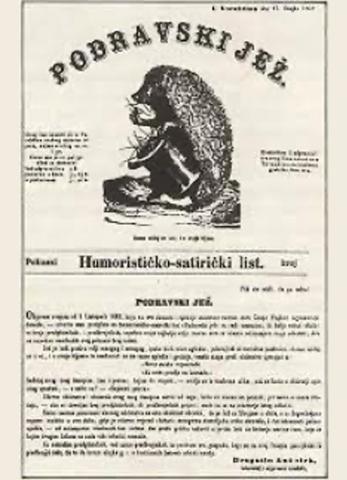
Podravski jež

Bič
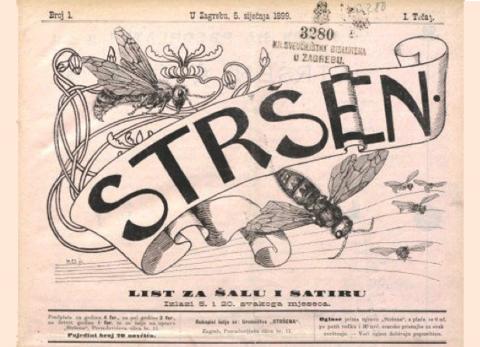
Stršen
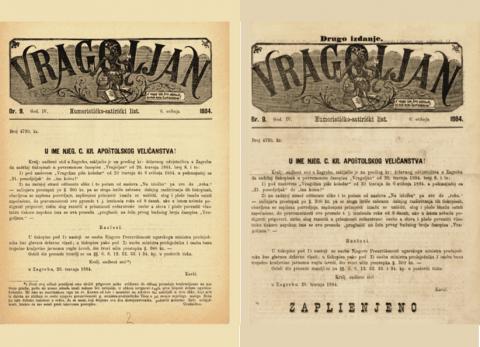
Vragoljan
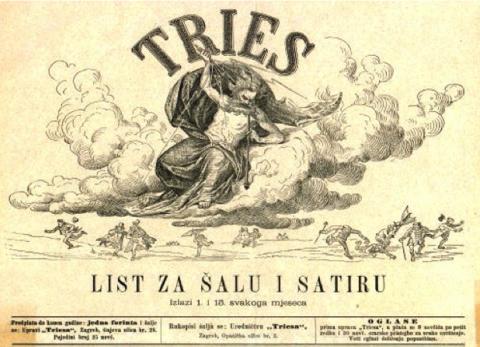
Tries
Fuente de las cubiertas: Registros bibliográficos del Catálogo de la Biblioteca Municipal de Zagreb
Source of covers: Bibliographic records of the Zagreb City Library Catalogue
Croatian humor magazines | Part 1
By Dražen Jergović
Podravski jež by Dragutin Antolek was the first humor magazine in the Croatian language. Its editor was a Varaždin activist against German and Hungarian influence, an Illyrian, a jurist, and a politician. The first issue was published on March 17, 1862, with a print run of 2,000 copies. Humor is the most difficult journalistic form, and when censorship and strong surveillance by those in power are added, it was hard for both the magazine and its editors to survive under such conditions. The fall of Bach's absolutism along with weakened Germanic influence helped the magazine's popularity. The inhabitants of these regions have always cultivated a penchant for jokes, pranks, and witty remarks, in which Antolek was a leader. The magazine was published on the 10th, 20th, and 30th of each month. The first public subscription call after printing 1,100 copies was sent by the editor to citizens as early as October 12, 1861, but the response was weak.
As source (Yearbook of the City Museum, No. 6, Varaždin 1981, article by Antun Golob) states: “It was a square-shaped leaflet, 60x50 cm, with four pages, illustrated with engravings. Sharp articles against Germans and Germanization predominated. Under the heading 'Podravski jež' was an image of a hedgehog sitting on its hind legs and eating from the top hat of a 'švabe' (pejorative term for Germans), and below the image, the motto: 'Buddy, rely on yourself and your own horse.' The other pages, alongside rousing songs and provocative drawings, abounded in jokes and pictures. On the last page, there was a drawing of a German in a tailcoat with a top hat, standing in front of a large pot (on a campfire), cooking 'frankfurter' sausages and offering them to two Croats in surkas (short wool coats).” The opportunistic magazine opposing Jež was the Hungarian-oriented Agramer Zeitung from Zagreb.
The difficult period that gradually subsided strengthened optimism, cheerfulness, and an increasingly pronounced tendency towards laughter and good spirits, as a stimulus for better times. Antolek’s sharp satire was primarily directed at national and political adversaries. Varaždin was known as a city of legendary princes of humor and satire. Popular at that time were the so-called huncutarije – small pranks typical of the Varaždin region. On their foundations grew the first better-known satirical literary works: “Matijaš Grabancijaš Dijak” by Tituš Brezovački and “Petrica Kerempuh” by Jakob Lovrenčić. Before that, in 1848, only one issue of Lucifer, but in German, was published in Varaždin.
For a short time (July 1, 1877 – March 31, 1878) Humoristički list, edited by Vjekoslav Raić, was published in Zagreb. The magazine came out twice a month with a format of 32 cm in height.
A few years later in Croatia, several more humor magazines were published with a strong political emphasis. The first and perhaps the most famous among them was Vragoljan from Bakar. It was a biweekly edited by Josip Horvat, where rights and Ante Starčević – the “father of the homeland” – were highly praised. The magazine was published from 1881 to 1886 and was confiscated 32 times, among other reasons, for promoting the cults of Zrinski and Frankopan, with a pronounced anti-Vienna stance. The humor in the magazine was forced, its spirit critical, with poor illustrations and distorted figures. The rights-oriented satirical humor magazine Bič was published in Zagreb from 1883 to 1885. Articles and drawings were mainly directed against the rule of Ban Karoly Khuen-Hedervary. The editor was Gavro Grünhut, and as many as 27 of the 39 issues were censored.
In Zagreb, between 1891 and 1899, Trn was published, the most long-lasting of those mentioned, edited by Josip Zvečeka (co-authored by politician Ante Starčević, a notable rights advocate). It was known to be published twice a month, and of its total number, 28 issues were confiscated. The reason it lasted so long was that its humor was milder and almost completely harmless to the current regime. After it came the magazine for jokes and satire Stršen, published at the very end of the 19th century (1899–1900), edited by Ivan Lončarić with publishing support from Mirko Supek. A third of its issues (16 of 46) were confiscated, and it was printed on the 5th and 20th of each month on paper measuring 42 cm in height, also in Zagreb. Due to frequent bans, some censored issues were published as second editions. Zagreb’s Tries, from November 1885 to May 1886, was edited by Stjepan Zavrlić. This magazine was the real successor to Bič, with publishing support from Ivan Krajač as publisher. Four out of 14 issues were confiscated.
The first humor magazine in Slavonia was Novogradiško blebetalo, which appeared in 1895 in Nova Gradiška thanks to HPD Graničar and the Mavro Bauer printing house. The first issue was published on June 9, 1895 in the garden of the Old Brewery in Nova Gradiška on the occasion of a concert to help those affected by the Ljubljana (Slovenia) earthquake. Only one issue of this humorous magazine edited by Ivan Zatluke and friends was published. It humorously mocked local flaws and social shortcomings. As available online source (https://novagra.hr) notes: “a multitude of prose and poetic texts dominated by political and communal issues, funny contests, acknowledgments, marriage ads, and other town ornaments.” The magazine’s successors were: Blebetalo, Veseli brat, Komarac, and Aprilska trava, which will be discussed further in the next issue.
(This text has been translated into English by ChatGPT)

